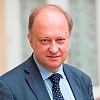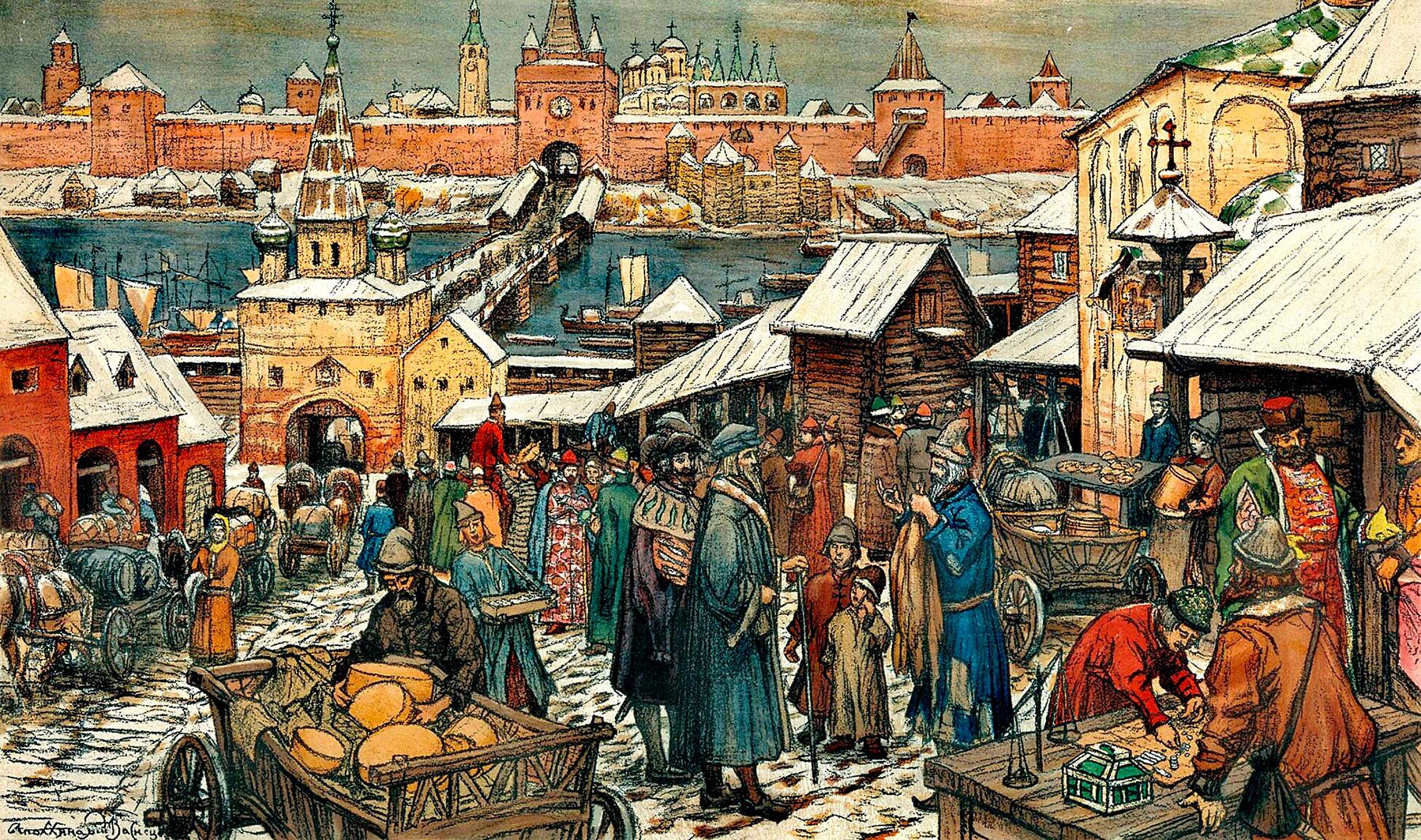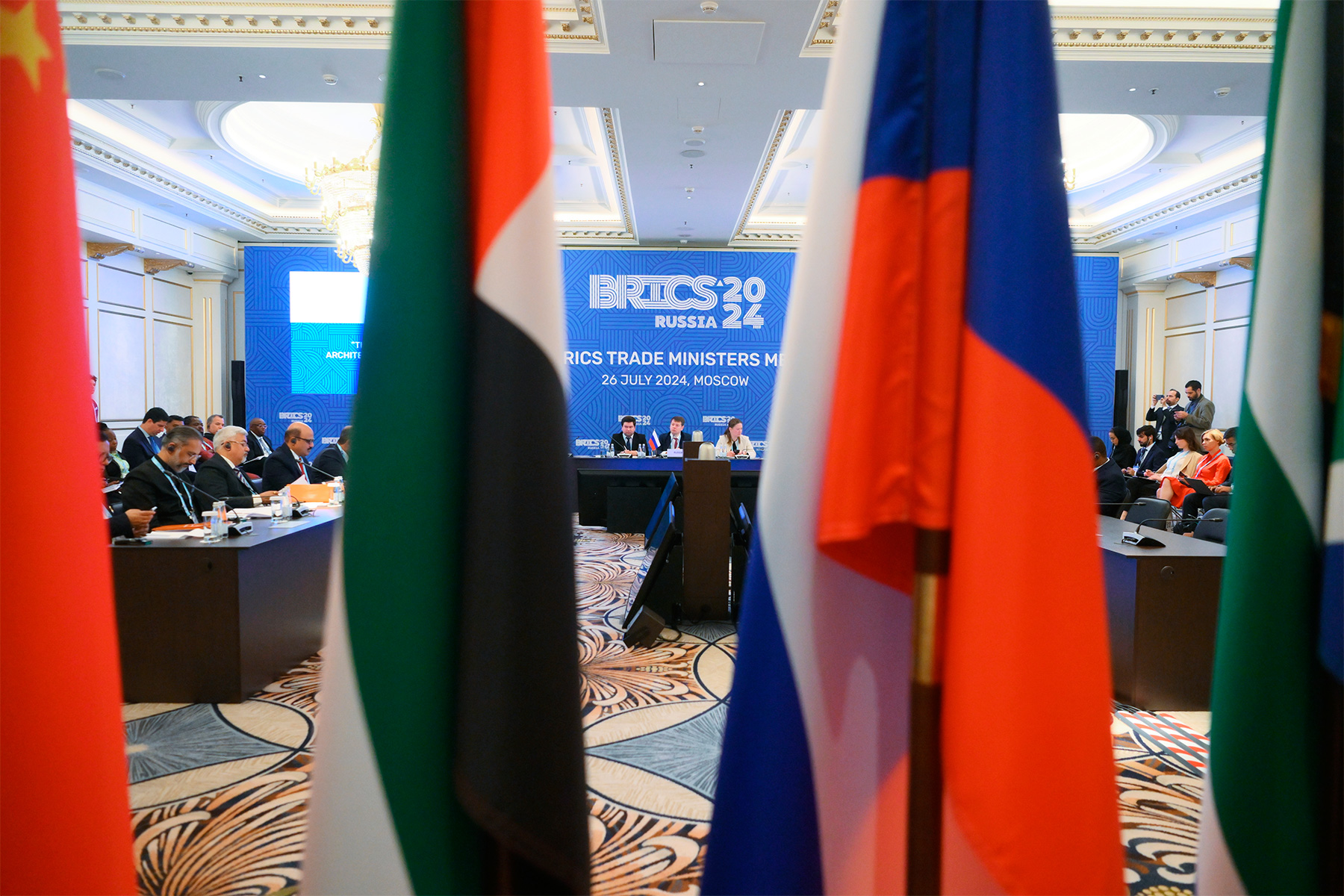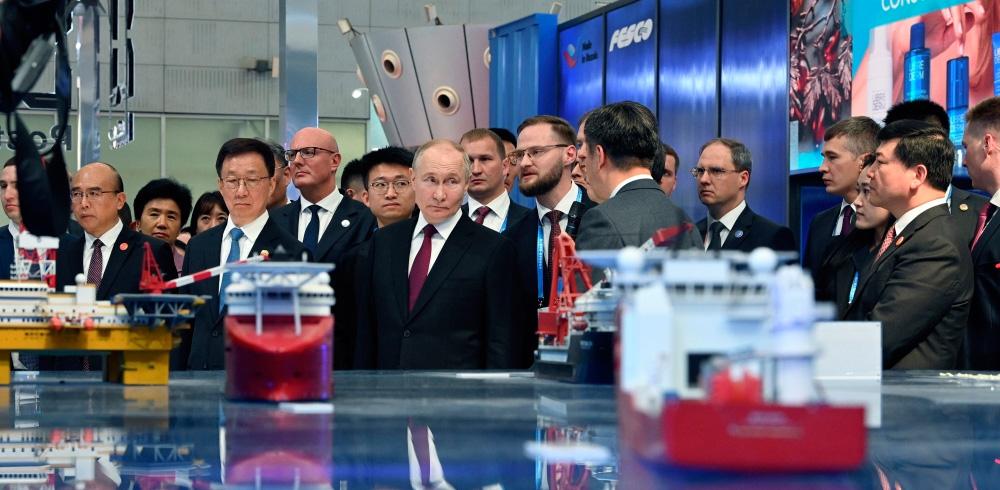When in February 2022 Moscow launched its special military operation in Ukraine, most experts—Russian and foreign alike—predicted a very sharp and deep decline in the country’s economic performance. They believed that by the end of 2022 the likely economic contraction would amount to 8–12% of the national GDP and would continue in 2023–2024, if the Russian-Ukrainian conflict was not resolved early enough. These very pessimistic assumptions logically led to many quite negative social and political scenarios, including a rapid social polarization, swiftly growing regional discrepancies, shrinking power-base of Russia’s leadership, rising radical opposition parties and even a political regime change in Russia.
However, the economic reality turned out to be different. Contrary to expectations of a financial and economic collapse, the Russian economy demonstrated a spectacular degree of resilience. Factors such as a strong ruble, high energy prices, and the ability to adapt to new trade partners contributed to a much less severe economic contraction; in fact, by the end of 2022, contrary to earlier predictions, the Russian economy declined by only 2.5%.
This trend continued throughout 2023. Russia once again outperformed most of the expert expectations: instead of 1.5–2.5% anticipated annual growth, the economy surprisingly grew by 3.6%. The main driver of this growth was an increased domestic demand—particularly, pubic spending, residential construction boom (based on state subsidized mortgage programs) and, of course, the defense sector. Though the rise of the defense budget was not a meteoric as in the previous year in 2023 it reached USD 109 billion demonstrating a rather modest 7% growth. This slowdown allegedly resulted not from the shortage of funding, but rather from the production capacity limitations of the national defense industry. Moreover, in 2023 there was a fast recovery in household consumption after a downturn a year earlier.
The pressure of Western sanctions was steadily increasing not only on Russia itself, but also on its key partners in the Global South through various instruments of ‘secondary sanctions’; however, this pressure did not prevent a continuous rise of Russia’s trade with China (up to USD 240 billion) and India (USD 65 billion).
Earlier forecasts of Russia’s 2024 economic performance made by IMF and IBRD in January suggested that the Russian economy would grow by 2.6–2.9%. However, in April IMF had to revise its earlier assessments, raising the projected annual Russia’s economic growth up to 3.2%. Most of forecasts for 2025 and for later envisage a slowdown—IMF is more radical in its predictions (1.5% for 2025), while the Russian government is more optimistic (2.3–2.4%).
It seems that everybody agrees about the Russian economy slowing down in the immediate future, but there are still significant disagreements about the pace and the length of this slowdown period. The key question here is about the sources of Russia’s resilience. Pessimists believe that the sources of this resilience are primarily situational and short-term. If the recent successes in Russian economic adjustment are confined to the swift increase in military spending, preferential public funded mortgage programs, high Central Bank interest rates and a favorable global market environment, these successes are not likely to last for too long. The positive economic dynamics might deplete itself if not in 2025, then in 2026 or in 2027.
Optimists argue that the sources of resilience are not only situational and short-term, but also strategic and long-term. In their opinion, after the beginning of the special military operation in February of 2022, Russia entered a period of a fundamental economic transformation, which implies much more than just a radical change in the foreign trade priorities or any other tactical adjustments. This transformation also includes an emphasis on the domestic market, an aggressive import substitution policy, more consistent and larger-scale support for national R&D, modernization of higher education and vocational training, more favorable climate for small and medium size business, and so on. It also includes major pubic investments into the urban infrastructure, transportation and logistics, the green transition and public health. For optimists, the beginning of the Russian-Ukrainian conflict was only the trigger that forced the country’s leadership to accelerate the long overdue upgrade of the old and arguably already antiquated economic system that had emerged in Russia in early 2000s.
Only time will tell whether optimists or pessimists are right in their assessments of the ongoing changes in the Russian economy and their likely dynamics even in mid-term future. It also remains an open question whether a profound restructuring of the national economy is possible without touching the fundamentals of the existing political system or economic changes will sooner or later induce political changes, which might or might not generate new political risks and threats. However, even today one can single out two main groups of challenges that the Russian economy has to confront.
The short-term challenges are mostly related to numerous economic restrictions imposed on Russia by the West. It would be wrong to assume that all of them were put in place only after the beginning of the Russian-Ukrainian conflict in early 2022; unilateral economic restrictions have been for a very long time a more or less standard feature of the Western foreign policies, especially that of the United States. However, the scale and the diversity of sanctions imposed on Russia in 2022–2024 are unprecedented. By the end of the first year of Moscow’s special military operation in Ukraine Russia already was under altogether 14 022 sanctions, which turned the country into the global ‘sanctions leader’ well above Iran (4 191), Syria (2 643), DPRK (2 133), Belarus (1 155) and Venezuela (651). This practice continued in 2023 and in 2024; today, the overall number of anti-Russia sanctions introduced in the West is approaching twenty thousand. There are no reasons to expect most of these sanctions to be lifted or significantly softened even if there is a cease-fire with Ukraine.
Putting aside Western sanctions and shifting to longer-term strategic challenges to Russia’s economy, one could focus on three interconnected trends: (1) changing Russia’s demographics, (2) shifts in the global trade structure and (3) transition to the post-information society resulting from the fourth industrial revolution. The way how Russia responds to these challenges will ultimately define its role in the international economic system in the second half of the XXI century.
When in February 2022 Moscow launched its special military operation in Ukraine, most experts—Russian and foreign alike—predicted a very sharp and deep decline in the country’s economic performance. They believed that by the end of 2022 the likely economic contraction would amount to 8–12% of the national GDP and would continue in 2023–2024, if the Russian-Ukrainian conflict was not resolved early enough. These very pessimistic assumptions logically led to many quite negative social and political scenarios, including a rapid social polarization, swiftly growing regional discrepancies, shrinking power-base of Russia’s leadership, rising radical opposition parties and even a political regime change in Russia.
However, the economic reality turned out to be different. Contrary to expectations of a financial and economic collapse, the Russian economy demonstrated a spectacular degree of resilience. Factors such as a strong ruble, high energy prices, and the ability to adapt to new trade partners contributed to a much less severe economic contraction; in fact, by the end of 2022, contrary to earlier predictions, the Russian economy declined by only 2.5%.
Some of the factors contributing to the resilience of the Russian economy—such as a relatively favorable dynamics of global oil and gas prices caused by the post-COVID economic recovery—had mostly external nature. This 2022 surge in energy prices provided the Russian government with substantial fiscal resources, allowing it to maintain higher levels of spending, including not only the defense sector (the military budget went through 50% rise within one year: it climbed from USD 65.9 billion in 2021 to 102 billion in 2022), but also major social programs and generous subsidies to the poorest regions. Indeed, the Russian leadership was in a position to fund both buns and butter without stretching itself too thin.
Other factors reflected a high degree of professionalism demonstrated by the Federal Government and by the Central Bank that managed to quickly suppress inflation, to balance the budget and to prevent an uncontrolled national currency devaluation. Apparently, the leadership learned its lessons from previous crises that the Russian economy had gone through at least three times since the beginning of century. Furthermore, the Russian leadership managed to promptly redirect the most important trade flows to non-sanctioning countries, such as China, India, Turkey, which mitigated the anticipated economic fallout of the Western economic pressure on Moscow.
This trend continued throughout 2023. Russia once again outperformed most of the expert expectations: instead of 1.5–2.5% anticipated annual growth, the economy surprisingly grew by 3.6%. The main driver of this growth was an increased domestic demand—particularly, pubic spending, residential construction boom (based on state subsidized mortgage programs) and, of course, the defense sector. Though the rise of the defense budget was not a meteoric as in the previous year in 2023 it reached USD 109 billion demonstrating a rather modest 7% growth. This slowdown allegedly resulted not from the shortage of funding, but rather from the production capacity limitations of the national defense industry. Moreover, in 2023 there was a fast recovery in household consumption after a downturn a year earlier.
The pressure of Western sanctions was steadily increasing not only on Russia itself, but also on its key partners in the Global South through various instruments of ‘secondary sanctions’; however, this pressure did not prevent a continuous rise of Russia’s trade with China (up to USD 240 billion) and India (USD 65 billion).
According to the very recent data released by President Vladimir Putin, in the first half of 2024, the national economic growth amounted to almost unbelievable 4.6%. There are concerns that the economy might be overheated and over the second half of year it should perform a kind of ‘soft landing’ assisted by high Central Bank interest rates. Indeed, the current annual inflation rates in Russia are 8.6% against the announced target of 4%. Still, the growth of average disposable incomes of Russian households (14% over last year) outstrips inflation by a broad margin and constitutes a basis for social and political stability in the country.
Earlier forecasts of Russia’s 2024 economic performance made by IMF and IBRD in January suggested that the Russian economy would grow by 2.6–2.9%. However, in April IMF had to revise its earlier assessments, raising the projected annual Russia’s economic growth up to 3.2%. Most of forecasts for 2025 and for later envisage a slowdown—IMF is more radical in its predictions (1.5% for 2025), while the Russian government is more optimistic (2.3–2.4%).
It seems that everybody agrees about the Russian economy slowing down in the immediate future, but there are still significant disagreements about the pace and the length of this slowdown period. The key question here is about the sources of Russia’s resilience. Pessimists believe that the sources of this resilience are primarily situational and short-term. If the recent successes in Russian economic adjustment are confined to the swift increase in military spending, preferential public funded mortgage programs, high Central Bank interest rates and a favorable global market environment, these successes are not likely to last for too long. The positive economic dynamics might deplete itself if not in 2025, then in 2026 or in 2027.
Optimists argue that the sources of resilience are not only situational and short-term, but also strategic and long-term. In their opinion, after the beginning of the special military operation in February of 2022, Russia entered a period of a fundamental economic transformation, which implies much more than just a radical change in the foreign trade priorities or any other tactical adjustments. This transformation also includes an emphasis on the domestic market, an aggressive import substitution policy, more consistent and larger-scale support for national R&D, modernization of higher education and vocational training, more favorable climate for small and medium size business, and so on. It also includes major pubic investments into the urban infrastructure, transportation and logistics, the green transition and public health. For optimists, the beginning of the Russian-Ukrainian conflict was only the trigger that forced the country’s leadership to accelerate the long overdue upgrade of the old and arguably already antiquated economic system that had emerged in Russia in early 2000s.
Only time will tell whether optimists or pessimists are right in their assessments of the ongoing changes in the Russian economy and their likely dynamics even in mid-term future. It also remains an open question whether a profound restructuring of the national economy is possible without touching the fundamentals of the existing political system or economic changes will sooner or later induce political changes, which might or might not generate new political risks and threats. However, even today one can single out two main groups of challenges that the Russian economy has to confront.
The short-term challenges are mostly related to numerous economic restrictions imposed on Russia by the West. It would be wrong to assume that all of them were put in place only after the beginning of the Russian-Ukrainian conflict in early 2022; unilateral economic restrictions have been for a very long time a more or less standard feature of the Western foreign policies, especially that of the United States. However, the scale and the diversity of sanctions imposed on Russia in 2022–2024 are unprecedented. By the end of the first year of Moscow’s special military operation in Ukraine Russia already was under altogether 14 022 sanctions, which turned the country into the global ‘sanctions leader’ well above Iran (4 191), Syria (2 643), DPRK (2 133), Belarus (1 155) and Venezuela (651). This practice continued in 2023 and in 2024; today, the overall number of anti-Russia sanctions introduced in the West is approaching twenty thousand. There are no reasons to expect most of these sanctions to be lifted or significantly softened even if there is a cease-fire with Ukraine.
Three types of sanctions are particularly important in terms of their impact on Russia’s economy. First, sanctions against Russia’s financial sector. Already in 2022, they froze Russian state financial assets that had been deposited in the West (about USD 300 billion). The odds are that the Kremlin will never get this money back. In addition, Western banks, insurance companies, hedge funds and other financial institutions can no longer make either direct or portfolio investments into the key sectors of Russia’s economy. Financial sanctions have a significant impact on the Russian economy since the West in general and the European Union in particular used to be the main source of FDIs in Russia. At the same time, all the financial sanctions imposed on Moscow over the last two years and a half have forced the Kremlin to gradually build its financial ecosystem completely separated from the West, which contributed to the overall resilience of the national economy.
The second type are sanctions against Russia’s energy sector—primarily against the oil and gas export, but also against Russia’s atomic power plant construction projects, against the Russian participation to multilateral international energy projects and so on. That was arguably the most difficult part of the overall sanction package for its initiators, given the high degree of the EU dependence on Russia’s hydrocarbons. Back in 2021 Russia accounted for about 40% of all the gas imported by the European Union, and in 2023 its share plummeted to only 8%. However, LNG remained a notable exception—in 2023, Russia remained the EU's second-largest LNG supplier, accounting for about 16% of total LNG imports, which is an increase from previous year. It should be noted that redirecting pipeline gas export to Asian markets (unlike LNG) remains a challenge for Russia as well, since such a shift requires building a lot of new and expensive pipeline infrastructure. Moscow has also managed to redirect its substantial oil exports that had previously been directed to Europe: in July of 2024, China and India were the largest importers of Russian crude oil, accounting for 47% and 37% of exports respectively, while the EU's share has dropped to about 7%.
The third and the most controversial type of the Western sanctions covers the Russian hi-tech sector. The intention the initiators is clear—to slow down or even, if possible, to reverse Russia’s progress in the most advanced sectors of national economy including modern machine tool building and metalworking, the chemical industry, electronics, industrial automation, optics, navigation equipment production, energy battery production, the aerospace industry and many others. This is the area where most of the so-called secondary sanctions were imposed on third-countries companies that continued their cooperation with Russian partners. The immediate impact of these sanctions was significant in some sectors of the Russian economy (e. g. car and civilian aircraft manufacturing), but their long-term implications for Russia's technological and economic performance remain uncertain. The sanctions have forced Russia to adapt quickly, especially in the defense-related sectors, but the sustainability of such adaptations, particularly in high-tech industries, is still debated in Russia and abroad.
Putting aside Western sanctions and shifting to longer-term strategic challenges to Russia’s economy, one could focus on three interconnected trends: (1) changing Russia’s demographics, (2) shifts in the global trade structure and (3) transition to the post-information society resulting from the fourth industrial revolution. The way how Russia responds to these challenges will ultimately define its role in the international economic system in the second half of the XXI century.
Most international demographic forecasts for Russia are based on the assumption that the population of the country will decline. For example, according to a report by the United Nations Department of Economic and Social Affairs (DESA), Russia's population will decline to 132.7 million by 2050. Russian experts, as a rule, are more optimistic—in their positive scenarios Russia’s population might rise to 160 million by the middle of the century—provided that external migration not only from the former Soviet Union, but also from the Middle East, Africa and even Latin America grows significantly, as well as due to the expected increase in the birth rate after 2029. At the same time, even the most optimistic forecasts proceed from the fact that the population of Russia will inevitably age rapidly, and by 2050 the share of people over 65 will reach almost one quarter. That raises a fundamental question of economic productivity, where Russia still lags significantly behind the most advanced nations.
The shifts in the global trade structure caused by the ongoing energy transition produce difficult challenges for Russia. Back in 2022, the global oil trade in amounted to USD 1.45 trillion, or 6.13% of the total global trade. However, this share will inevitably decrease, since by 2045 world oil consumption will grow by only 16%, and competition for consumers in world energy markets will further intensify. Sooner or later, the same downturn trend will affect global natural gas markets. More favorable opportunities for Russia are likely to remain in the field of nuclear energy, but international competition in the construction of nuclear power plants will undoubtedly only grow. Russia will have to define new place for itself within the international division of labor, which will be an uphill battle.
With the fourth industrial revolution taking speed, diverse high-tech goods and a wide range of services will increasingly dominate world trade, with small and medium-sized enterprises getting more apace and influence among international trade actors. On the other hand, traditional trade will begin to give way more and more clearly to advanced production cooperation, when the standard exchange of goods and services is replaced by forging bilateral or multilateral production and technological chains. Thus, in the emerging economies, foreign direct investment will be more important than traditional trade. So far, Russia does not have a lot of experience in participating to such cross-border production and technological chains; this is an art that it still has to muster.
First published in the Guancha.cn







